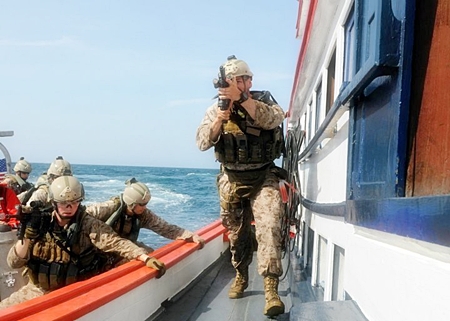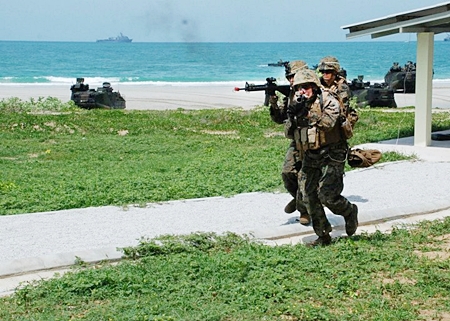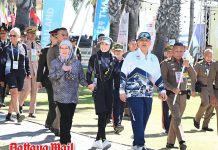Thai and American naval forces wrapped up their 18th Combat Afloat Readiness and Training exercise, which this year focused extensively on amphibious assault.
Royal Thai Fleet commander Adm. Kanat Thongpool presided over the May 25 closing ceremonies for the nine-day exercise in Sattahip. Rear Adm. Paithoon Prasopsin, commander of the Royal Thai Navy’s Frigate Squadron 2, and Rear Adm. Thomas F. Carney, commander of the U.S. Logistics Group for the Western Pacific, represented the battle groups for the two nations.
 U.S. Navy Musician 3rd Class Gabriel Brown, a vocalist with the U.S. 7th Fleet Band “Orient Express” performs at the Darasamut Catholic School CARAT 2012. (U.S. Navy photo by Chief Mass Communication Specialist Daniel J. Calderon/Released)
U.S. Navy Musician 3rd Class Gabriel Brown, a vocalist with the U.S. 7th Fleet Band “Orient Express” performs at the Darasamut Catholic School CARAT 2012. (U.S. Navy photo by Chief Mass Communication Specialist Daniel J. Calderon/Released)
CARAT employed five U.S. ships and nine Thai vessels. “Special Mission Forces” were created, using sailors, divers, staff from the Thai Naval Ordinance Department. A total of eight aircraft and 2,500 personnel took part.
Kanat said this year’s war games focused on use of unmanned aerial vehicles and mobile medical services training. A big portion of the training was devoted to amphibious assaults.
The exercise’s finale May 24 saw the HTMS Surin and USS Germantown coordinate a simulated attack on Sattahip’s Yao Beach utilizing 18 amphibious vehicles, hundreds of sailors and marines and two F-16 aircraft.
 Royal Thai and U.S. Service members compete in a sack race during a joint sports day event for Cooperation Afloat Readiness and Training (CARAT) Thailand 2012. (U.S. Navy photo by Mass Communication Specialist 1st Class Robert Clowney/Released)
Royal Thai and U.S. Service members compete in a sack race during a joint sports day event for Cooperation Afloat Readiness and Training (CARAT) Thailand 2012. (U.S. Navy photo by Mass Communication Specialist 1st Class Robert Clowney/Released)
The training covered planning to boarding combat ships and setting of equipment, followed by moving forces to targeted areas. The most important training step came before using the amphibious attack with a special force sent to destroy all obstacles. Then the F-16 aircraft dropped bombs at the beach.
The training was divided into three parts consisting of training at harbors and in the field, sea training and summarization and training evaluation in the Sattahip field and the upper Thai Gulf.
Apart from training, participants also took part in community relations projects, offering medical and other community services.
 U.S. Marines, assigned to Fleet Anti-terrorism Security Team Pacific (FASTPAC), board a Thai fishing vessel from a U.S. Coast Guard short range prosecutor during a visit, board, search and seizure (VBSS) exercise with the Royal Thai Navy (RTN). The RTN sailors and officers pretended to be fisherman who had their vessel boarded by the Marine FASTPAC team. The VBSS exercise also included a maritime law enforcement team, assigned to USCGC Waesche (WMSL 751). (U.S. Navy photo by Mass Communication Specialist 1st Class N. Ross Taylor/Released)
U.S. Marines, assigned to Fleet Anti-terrorism Security Team Pacific (FASTPAC), board a Thai fishing vessel from a U.S. Coast Guard short range prosecutor during a visit, board, search and seizure (VBSS) exercise with the Royal Thai Navy (RTN). The RTN sailors and officers pretended to be fisherman who had their vessel boarded by the Marine FASTPAC team. The VBSS exercise also included a maritime law enforcement team, assigned to USCGC Waesche (WMSL 751). (U.S. Navy photo by Mass Communication Specialist 1st Class N. Ross Taylor/Released)
 U.S. Marines with Company F, 2nd Battalion, 3rd Marine Regiment, conduct a clearing exercise in a Military Operations on Urban Terrain (MOUT) training area as part of a simulated amphibious assault conducted with Royal Thai Marines. (U.S. Navy photo by Chief Mass Communication Specialist Daniel J. Calderón/Released)
U.S. Marines with Company F, 2nd Battalion, 3rd Marine Regiment, conduct a clearing exercise in a Military Operations on Urban Terrain (MOUT) training area as part of a simulated amphibious assault conducted with Royal Thai Marines. (U.S. Navy photo by Chief Mass Communication Specialist Daniel J. Calderón/Released)
 Royal Thai Marines set off a charge as part of a simulated amphibious assault conducted with U.S. Marines for Cooperation Afloat Readiness and Training (CARAT) Thailand 2012. (U.S. Navy photo by Chief Mass Communication Specialist Daniel J. Calderón/Released)
Royal Thai Marines set off a charge as part of a simulated amphibious assault conducted with U.S. Marines for Cooperation Afloat Readiness and Training (CARAT) Thailand 2012. (U.S. Navy photo by Chief Mass Communication Specialist Daniel J. Calderón/Released)




